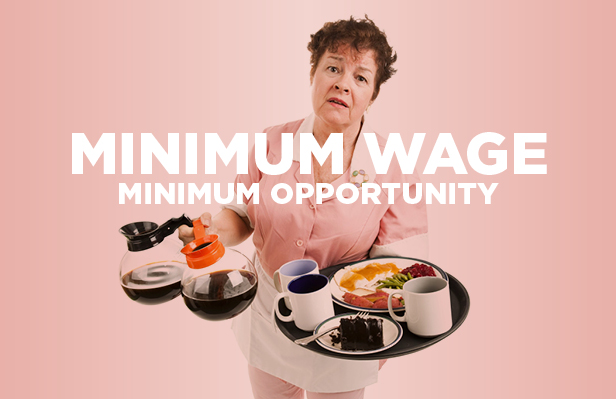Fact Sheet

The Harmful Effects of a Minimum Wage Increase
In his 2014 State of the Union address, President Obama proposed increasing the minimum wage from $7.25 to $10.10 an hour. Although it sounds beneficial to low-wage workers, minimum wage hikes fail to reduce poverty and result in fewer jobs. Instead of increasing costs for employers, lawmakers should focus on expanding job opportunities through pro-growth policies, thereby raising wages for all.
Minimum Wage Increases Hurt the Most Vulnerable
- A National Bureau of Economic Research review of more than 100 minimum wage studies found that the vast majority concluded raising the minimum wage increases unemployment for low-wage workers.
- The U.S. Department of Labor’s assessment of the first 25-cent minimum wage in 1938 found job losses for 30,000 to 50,000 workers.
- In 2007, Pennsylvania gradually increased the minimum wage from $5.15 to $7.25. Businesses reacted by raising prices or laying off workers and non-profits faced program cuts.
- The Pennsylvania Chamber of Business and Industry reported roughly 70 Kennywood Park employees—largely high school and college students—were laid off and ticket prices were increased.
- The Philadelphia Inquirer reported that the Philadelphia Youth Network—a program offering summer jobs to low-income teens—would need to cut 1,100 jobs if they did not receive more state funding, which was necessitated by an increase in the minimum wage.
- According to the U.S. Bureau of Labor Statistics, the labor force participation rate for 16 to 19 year olds has steadily declined. Today, only 32% of teens have jobs compared to 42% in January of 2007.
- A 2014 Congressional Budget Office analysis found increasing the minimum wage to $10.10 would eliminate about 500,000 jobs for low-wage workers.
- A recent report from the National Federation of Independent Businesses found three proposed minimum wage bills in Pennsylvania would reduce employment. One bill was estimated to result in more than 118,000 lost jobs in ten years, mostly from small businesses.
- Joe Olivo, owner of a small printing business, explains why a higher minimum wage would result in layoffs: “I couldn’t make that up in raising prices. It would lead to layoffs and me looking at using more automation, at least I can control that cost.”
Most Minimum Wage Earners are Young, Childless and Middleclass
- In 2013, 3.2% of Pennsylvania workers earned at or below the minimum wage, according to Census figures. While overall employment increased, fewer workers made minimum wage in 2013 than in 2012.
- Less than a quarter of all minimum wage earners come from households at or below poverty, according to a Heritage Foundation analysis.
- In Pennsylvania, 58% of minimum wage earners are younger than 25, and about 26% are teenagers.
- Among Pennsylvanians earning at or below the minimum wage, 81% do not have children.
- According to the Heritage Foundation, two-thirds of minimum wage workers receive a raise within a year.
The Minimum Wage is Not an Effective Tool for Reducing Poverty
- According to the U.S. Census, since 2003, poverty in Pennsylvania has increased from 10.5% to 12.6%, despite an increase in the minimum wage.
- According to a study by the Employment Policies Institute, less than 10% of the beneficiaries of a $9.80 minimum wage are single parents with children.
- Increases in the minimum wage harm the populations most likely to be unemployed.Economists William Evan and David Macpherson found a 10% increase in a minimum wage decreases employment by 1.2% for Hispanic males without a diploma and 6.5% for black males without a diploma.
- In fact, more young Black men lost jobs due to minimum wage increases than the Great Recession.
- A 2013 analysis by Joseph J. Sabia, associate professor of economics at San Diego State University, found no evidence that higher minimum wages helped people avoid financial or health insecurity.
- As the Cato Institute has noted, there is no evidence that minimum wage increases reduce poverty among less-educated single mothers.
Policies that Help Reduce Poverty
- Lower the cost of doing business: It is possible to raise wages and increase hiring at the same time. According to a Mercatus Center study, a one-percentage point drop in the corporate tax rate would likely increase annual economic growth by 0.1 to 0.2%. This would make Pennsylvania more competitive and increase productivity, leading to more jobs and higher wages as outlined by a 2013 Commonwealth Foundation analysis.
- Reform welfare: Restructure welfare programs to reward work thereby avoiding the arbitrary benefit cutoffs that discourage employment and trap families in poverty.
- Increase school choice: Ensure young people are well-educated by offering an alternative to failing schools through school choice. Unfortunately, too many kids today are trapped in violent and failing schools.
- Lower barriers to entry: Scale back professional licensing to give low-wage earners the opportunity to increase their incomes through entrepreneurship.